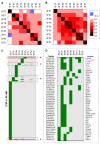Genetic Complexity in Spondyloarthritis: Contributions of HLA-B Alleles Beyond HLA-B*27 in Romanian Patients
- PMID: 40806743
- PMCID: PMC12347857
- DOI: 10.3390/ijms26157617
Genetic Complexity in Spondyloarthritis: Contributions of HLA-B Alleles Beyond HLA-B*27 in Romanian Patients
Abstract
This study examined the distribution and disease associations of non-HLA-B*27 HLA-B alleles in Romanian spondyloarthritis (SpA) patients, aiming to address the underrepresentation of Eastern European populations in immunogenetic research. Methods: We analyzed 263 HLA-B*27-negative patients from Northeastern Romania fulfilling ASAS criteria. HLA-B genotyping was performed at two-digit resolution, and allele distributions were compared with two Romanian HLA-B*27-negative control groups (n = 335 and n = 1705 cases), using chi-square testing and logistic regression. Compared to controls, HLA-B*47 (p = 0.0007) and HLA-B*54 (p = 0.0013) were significantly enriched, while HLA-B*40 was underrepresented (p = 0.0287). Notably, HLA-B*54 was observed exclusively in axial SpA. Within the cohort, both HLA-B*13 and HLA-B*57 alleles were associated with psoriasis, while HLA-B*37 and HLA-B*41 alleles were clustered within the reactive arthritis group. The HLA-B*35 and HLA-B*18 alleles were the most frequently observed alleles across most clinical phenotypes. When comparing the frequency of HLA-B associations, the most common genotypes among SpA patients were B*08-B*18, B*13-B*35, and B*35-B*51. Notably, B*08-B*18 was more frequent in patients with radiographic sacroiliitis grade ≥ 2, while B*35-B*51 was more frequent in those with confirmed systemic inflammation, as indicated by elevated CRP or ESR levels. Analysis of peptide-binding patterns revealed a cluster of risk alleles, HLA-B*08, B*18, B*35, B*40, and B*54, sharing similar features, distinct from the canonical profile of B*27. These findings highlight the contribution of non-B*27 HLA-B alleles to SpA susceptibility in an Eastern European population and support the notion that HLA-B*27-negative SpA may represent a distinct clinical and immunological entity, driven by alternative pathogenic mechanisms. They also emphasize the importance of population-specific immunogenetic profiling and support expanding genetic characterization in HLA-B*27-negative patients.
Keywords: HLA-B*27-negative; Romanian cohort; cross-reactivity; immunogenetics; spondyloarthritis.
Conflict of interest statement
The authors declare no conflicts of interest.
Figures


Similar articles
-
Prescription of Controlled Substances: Benefits and Risks.2025 Jul 6. In: StatPearls [Internet]. Treasure Island (FL): StatPearls Publishing; 2025 Jan–. 2025 Jul 6. In: StatPearls [Internet]. Treasure Island (FL): StatPearls Publishing; 2025 Jan–. PMID: 30726003 Free Books & Documents.
-
HLA B27 antigen in Middle Eastern and Arab countries: systematic review of the strength of association with axial spondyloarthritis and methodological gaps.BMC Musculoskelet Disord. 2017 Jun 29;18(1):280. doi: 10.1186/s12891-017-1639-5. BMC Musculoskelet Disord. 2017. PMID: 28662723 Free PMC article.
-
HLA-DRB1 and DQB1 Allelic Polymorphism and Multiple Sclerosis in a Moroccan Population.Curr Issues Mol Biol. 2025 Jun 13;47(6):458. doi: 10.3390/cimb47060458. Curr Issues Mol Biol. 2025. PMID: 40699857 Free PMC article.
-
Associations of sociodemographic, clinical factors and HLA-B alleles with enthesitis and peripheral arthritis in patients with ankylosing spondylitis.RMD Open. 2025 Mar 12;11(1):e004589. doi: 10.1136/rmdopen-2024-004589. RMD Open. 2025. PMID: 40081912
-
Association of HLA class I and II genes with cutaneous leishmaniasis: a case control study from Sri Lanka and a systematic review.BMC Infect Dis. 2016 Jun 14;16:292. doi: 10.1186/s12879-016-1626-8. BMC Infect Dis. 2016. PMID: 27301744 Free PMC article.
References
-
- Rudwaleit M., van der Heijde D., Landewé R., Listing J., Akkoc N., Brandt J., Braun J., Chou C.T., Collantes-Estevez E., Dougados M., et al. The Development of Assessment of SpondyloArthritis International Society Classification Criteria for Axial Spondyloarthritis (Part II): Validation and Final Selection. Ann. Rheum. Dis. 2009;68:777–783. doi: 10.1136/ard.2009.108233. - DOI - PubMed
-
- Rudwaleit M., Van Der Heijde D., Landewé R., Akkoc N., Brandt J., Chou C.T., Dougados M., Huang F., Gu J., Kirazli Y., et al. The Assessment of SpondyloArthritis International Society Classifi Cation Criteria for Peripheral Spondyloarthritis and for Spondyloarthritis in General. Ann. Rheum Dis. 2011;70:25–31. doi: 10.1136/ard.2010.133645. - DOI - PubMed
-
- Cortes A., Hadler J., Pointon J.P., Robinson P.C., Karaderi T., Leo P., Cremin K., Pryce K., Harris J., Lee S., et al. Identification of Multiple Risk Variants for Ankylosing Spondylitis through High-Density Genotyping of Immune-Related Loci. Nat. Genet. 2013;45:730–738. doi: 10.1038/ng.2667. - DOI - PMC - PubMed
MeSH terms
Substances
LinkOut - more resources
Full Text Sources
Research Materials
Miscellaneous

